Practice Insights > Teachers for Inclusive Society
A Resourceful Science Teacher
Teacher: Dharmapal
School: Government Higher Primary School, Rajola (K), Sedam, Kalaburagi District, Karnataka
By: Sharad Sure and Mahaboob Peera
This article can be read in Kannada here
Dharmapal is a Trained Graduate Teacher (TGT) at the Government Higher Primary School (GHPS), Rajola (K), Sedam, Kalaburagi District. Rajola is a small village with about 280 families as reported in the 2011 Census. Post that, about 30 families have migrated from the village due to community conflict. The school has approximately 110 students enrolled in grades I to VII—60 boys and 50 girls. There are 37 students from the Scheduled Caste (SC) community and 19 students from Other Backward Castes (OBC). There are three teachers and one guest teacher currently working in the school.
The school has ten classrooms, which are sufficient for the number of students enrolled. Students in the lower classes, up to grade III, sit on the floor and are taught using the Nali-Kali approach. The higher classes have desks and benches. There is a dedicated science resource room, as well as a small conference room which can accommodate up to 50 students at a time. The school has a rectangular playground. Neat and green, the campus is attractive.

Dharmapal: A brief profile
Dharmapal joined the school in 2010 after completing his DEd from Tumkur and BSc from Kuvempu University. He went on to complete MSc in Physics through distance mode from the Kuvempu University. He has also qualified for the fellowship examination conducted by the Center for Scientific and Industrial Research (CSIR) for Physics and intends to do a PhD in thermodynamics.
Dharmapal hails from Tumkur and when he joined service in Kalaburagi, he felt that it was lagging behind by more than a decade in comparison with his region. In his assessment, in his own town, there would be 10 dropouts for every 1000 admissions but in Rajola, where he works, there were 185 enrollments but only about 55 students attend school regularly. The reason for this was fear among teachers to remove names from the student list. He also realized that though the community was financially stable, the people were not keen on engaging with the school. This though contradictory, was the reality.
The community’s lack of interest in the education of its children reflected in the students’ learning levels. Since almost half of his students’ mother-tongue was Telugu, so reading and writing in Kannada was a big challenge for them. Students completing grade VII were not fluent in reading and writing. They feared mathematics and science. So it wasn’t a surprise that they failed to get admission to high schools in the neighbourhood.
Groundwork to change the situation
Dharmapal realized that for any change to happen, he would need a complete overhaul. The community’s apathy towards schooling had persisted for a long time. The teachers too had been in the school for many years. A change would not be easily acceptable to the community or the other teachers.
In 2012, three teachers were transferred out of the school. Of the three remaining, only two were available for teaching at any given time due to various other responsibilities that needed to be handled in the school. This, though, was a challenge, but Dharmapal saw an opportunity in it. He started teaching the lower classes with a plan to follow a group of cohort throughout seven years of schooling. His belief was that once some improvement happened, it would be easier to engage the community. He took the other two teachers into confidence. To better understand and imagine what must have happened in the ensuing years as he followed the cohort for seven years, we need to observe what happens in the current grade VII classroom.
Student-centric pedagogic practices
Grade VII students were busy with their preparations for a seminar. They were presenting the topic, ‘Pollution’. The eight members of the group presenting it, took turns to talk about various aspects of pollution, such as pollutants, types of pollution, measures to reduce pollution. During the 15-minute presentation, students were confident and seemed to have rehearsed the sequence of the presentation, as well as the content, well. They had referred to various sources to gather information and the posters used indicated that the students had worked in a group to put them together.
 Students make one seminar presentation every month as part of a larger instructional strategy employed by the teacher. Dharmapal identifies three levels of a topic—difficult, average and easy—based on the self-learning opportunities for the students. The topic ‘pollution’ was considered as an average topic, which means that the students had to do some work in putting together all the information necessary to complete the learning. Topics, such as ‘Covalent bond’, for which the students would need to reference inaccessible sources are not assigned for seminars but are taken up for direct instruction by the teacher. Easier topics are left for self-learning. Dharmapal identifies the topic and mode of learning and prepares a time table for the same in advance. That gives the students ample time to understand their roles and prepare.
Students make one seminar presentation every month as part of a larger instructional strategy employed by the teacher. Dharmapal identifies three levels of a topic—difficult, average and easy—based on the self-learning opportunities for the students. The topic ‘pollution’ was considered as an average topic, which means that the students had to do some work in putting together all the information necessary to complete the learning. Topics, such as ‘Covalent bond’, for which the students would need to reference inaccessible sources are not assigned for seminars but are taken up for direct instruction by the teacher. Easier topics are left for self-learning. Dharmapal identifies the topic and mode of learning and prepares a time table for the same in advance. That gives the students ample time to understand their roles and prepare.

Time table displaying various student-driven activities across subjects
Students take an active part in the execution of scheduled activities. Within a group, they distribute aspects of the topic; prepare; and, rehearse the presentation. Since the number of teachers is less, many of their classes go without a teacher and students voluntarily take up the responsibility of organizing seminars and group discussions. They intimate their teacher so that the presentations are supervised and they can get insightful feedback. Most of these activities happen in the seminar hall.


Equipment in the Seminar Hall
The seminar hall has a projector connected to the CPU of a computer. Dharmapal bought the necessary hardware and assembled the CPU himself, which has made it affordable for the school.
Dharmapal has developed a science resource room which houses various laboratory equipments that are necessary for carrying out science experiments. There are many improvised scientific equipments that are developed at low or no cost using commonly available materials, like electric circuits and LED lamps. Dharmapal says support from the Azim Premji Foundation has been immense in running this laboratory. Getting laboratory chemicals that are essential for conducting experiments and demonstrations would otherwise have been difficult. He has been using the resources of the Teacher Learning Center (TLC) for classroom instruction. He gets the LCD projector issued in his name from the TLC to show videos to his students as a part of his instruction.

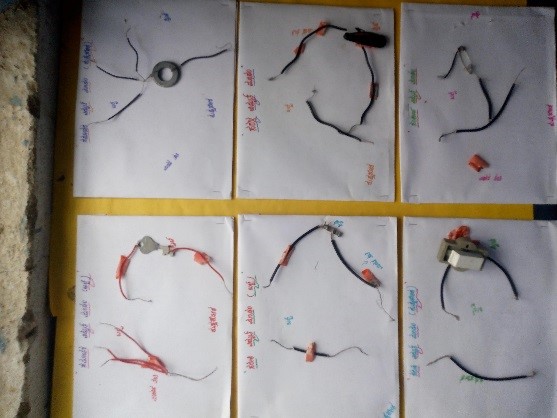
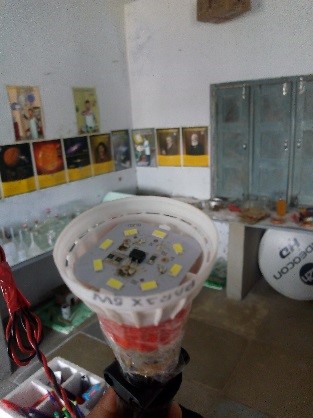
Glimpses of Science Laboratory and Resource Room
The laboratory is also used as a dark room for experiments and demonstrations related to light. Florescent stickers of stars and constellations have been stuck on the roof of the room allowing students to identify these. The blackboard in the laboratory displayed the good strategy of listing examples of different sources of light allowing students t_o process this knowledge and arrive at an understanding of the natural and artificial sources of light.
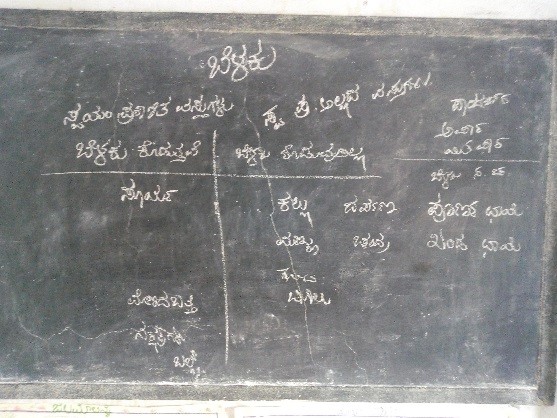
Blackboard displaying organized and selective use of examples for student engagement.
Apart from seminars, students engage in many other modes of learning like group discussions, assignments and models related to the contents in their textbooks. In each of these modes, they take the lead in learning rather than depending on classroom instruction.
Learning beyond the classroom can, literally, be seen everywhere on the school premises. The school has put up learning resources for students in all possible spaces. A Kannada learning resource collection can be seen near the corridor. Students are encouraged to read it for an hour after classes. This effort was named as ‘Operation Arjuna’ by Dharmapal. All this was done to overcome the language learning difficulty the students were facing. Mixed ability student groups were formed to focus on Listening, Speaking, Reading, and Writing (LSRW) component of language. Storytelling was practised every Saturday for two years. Ten students every week were given the opportunity to talk during the assembly time.
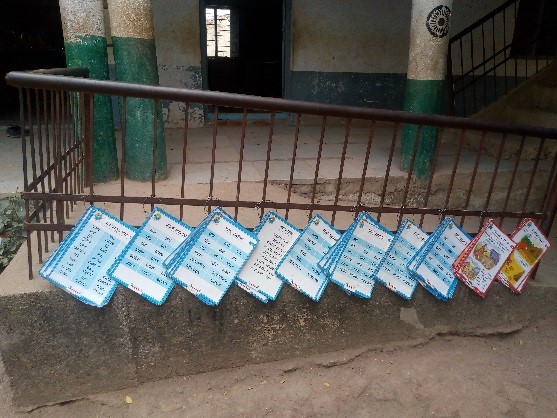
The school also has an environment-friendly policy. No unutilized plastic waste can be seen on the premises. Any plastic that comes in is reused creatively. The use of water bottles for cultivating plants is a good example.
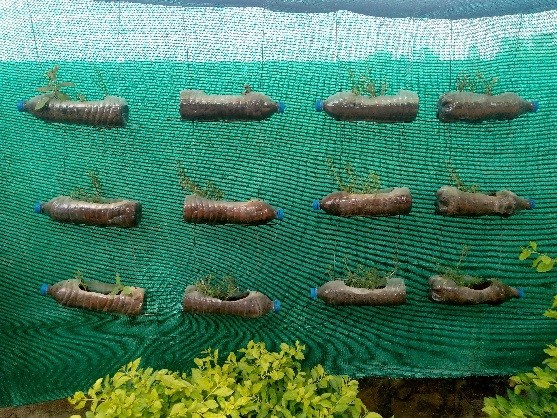

Dharmapal’s inspiration for all these activities comes from his understanding of the National Curriculum Framework (NCF), he says. Children being at the centre of the knowledge construction process, bringing in children’s understanding of the world, non-sequential learning by children are some of the principles from the NCF that he cited. He gave the example of his students learning about the structure of a flower to elaborate these. He thinks that students have the knowledge of a flower although they may not know it in the language of the textbooks. The classroom needs to bring in their experience of having seen and played with flowers. In the classroom, such multiple experiences need to be presented in a formal, organized manner leading to an understanding that is expected from the topic. Through these children-centric approaches, Dharmapal believes, apart from learning_ the content, children will also develop confidence. This is a key aspect that we need to develop in every child, he says. The variety of the pedagogical approaches he brings in, he believes, also relieves him from being a full-time instructor; rather, his role becomes that of a guide.
A Master Resource Person
Dharmapal participates regularly in the Teacher Learning Center (TLC) facilitated by the Foundation. He started off as a participant initially but his interactions, questions and contributions in sessions and workshops led to his becoming a resource person, quickly. He organized workshops for teachers in the block as part of teacher development initiatives. He identifies that many teachers have misconceptions about the content they are teaching and it is only through these workshops that the understanding can be developed among them. Dharmapal sees the value of interactive forums, like TLC, which bring the teachers together. He believes that it is only a select few who are really interested in benefitting from the forum to improve their classroom engagements. Dharmapal credits the Foundation with helping him develop the laboratory by providing basic resources needed and for continuously supporting him. He cites the science fair as the example of a very cooperative engagement between his school and the Foundation.
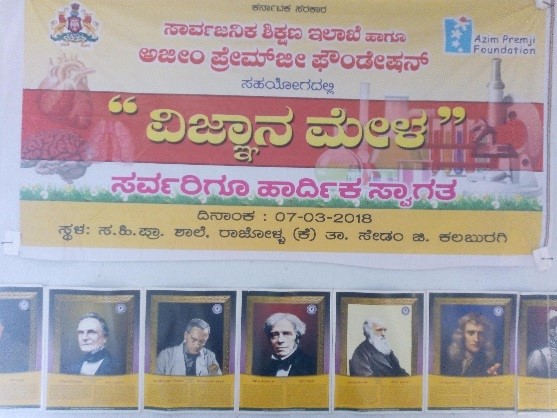
A banner welcoming people to the Science Fair jointly organized by Department of Public Instruction and Azim Premji Foundation at GHPS Rajola.
Dharmapal has been a Master Resource Person (MRP) for the Teacher Professional Development (TPD) program that was launched across the state of Karnataka. Dharmapal does not miss any opportunity for his own professional development, including online resources. Recently, he has subscribed to the e-content developed by BYJU’s at his own personal expense. He uses videos for his own understanding, as well as for classroom demonstrations. The Kahoot app is another example, he cites, that he uses frequently for his professional learning.
Relationship with the community
Dharmapal enjoys a very good relationship with the members of the community. His consistent efforts have resulted in the community engaging with the school. Community members who did not care about school and learning have started coming to school. All this happened due to the fact that the three teachers, including Dharmapal, continued to engage students in the learning process every day, including holidays. Children began to love coming to school. The school used opportunities to display the school work to the community. For example, on Republic Day and Independence Day, school children took out a parade through the residential areas. The community could not but observe the improvement in the children’s interest in learning.
The practice of casteism among the community members continues, so when group work is assigned, which necessitated that the students work together, some members of the community refused to let their children mingle with children from backward communities. It was the school that provided the learning space for children to work together. It remained open even on Sundays to facilitate this. Despite initial resistance from parents regarding the intermixing of students across communities, students have overcome the caste barriers. The school has achieved some success in this while the children are in school, at least.
Future plans
Dharmapal wants to develop a science park in the school. He has seen one at the Agastya International Foundation, Kuppam. He believes that such a park will make science learning fun and exciting. He has hosted a science fair successfully this year and wants to make it a permanent feature of the school that not only brings recognition for the school but also exposes the students to the world and people outside, making them confident.
Next year, Dharmapala completes ten years of service. He wishes that by then, he would be able to look back at a substantial amount of work that he has accomplished in the decade.
Problematic beliefs and practices
In 2012, when three of his colleagues were transferred from the school, there were only three teachers to manage 150 student groups. The only method that worked for Dharmapal, he believes, was punishment. He believes that children work out of fear. Children practice to avoid punishment. He strongly believes that children should fear the teacher and then the teacher needs to make efforts to take that fear out of them.
Dharmapal is well aware that this is against the law. He has also learnt in his teacher education that punishment does not help in developing appropriate behaviour. But on the ground, his experience was contrary to what he had learnt. He justifies his practice by saying that wherever there is fear, there will be devotion and devotion would lead to discipline. He says that whenever he punished a few students, the others were alarmed. And though he does not punish now, the fear of punishment is making his students work.
Dharmapal’s belief in punishment extends to teachers too. He believes that teachers do not show seriousness in their work or in teacher development activities because there are no consequences. There has to be punishment associated with their non-participation to ensure that they comply.
He says some parents challenged his practice of punishing students. But he didn’t change. He was even transferred out of the school for a brief period based on a complaint by some parents. He does not mind such consequences and says that since his practice has worked, he would continue it. He emphasises that it is only in the early years and only for some students, that punishment becomes necessary for them to fall into line.
Conclusion
One can see a dynamic teacher in Dharmapal. He seems to have read the NCF well and is clear about how to implement student-centric learning strategies. The variety of activities students engage in during their school time is an indicator of that. At the same time, he does not seem to believe that students should be spared the rod. His acts of punishment are a clear violation of children’s rights. These practices are also against the norms of schools. Despite that, Dharmapal is strongly convinced that punishment works in bringing about desirable changes in student behaviour. As a teacher who employs progressive teaching practices, his practice of punishment presents to us a unique case of a teacher whose beliefs are at two extreme ends of the polarity of progressive teaching practice at the same time.
Acknowledgements: Our sincere thanks to science teacher, Dharmapal for taking time out of his busy schedule to share his experiences and reflections on his professional practice. Our heartfelt thanks to the members of the community who took the time to visit the school and share their thoughts and experiences. Sincere thanks to the Gulburga District Institute, Azim Premji Foundation in identifying and giving a brief about the teacher and making all arrangements for the field visit.
AUTHORS
Sharad Sure, Faculty, Azim Premji University
Mahaboob Peera is the Science Resource Person at the Azim Premji Foundation, Kalaburagi for the last five years. He leads the science team at Kalaburagi in developing scientific temper imbibed in teacher’s professional development work. He has previously worked as a master trainee at the Agastya International Foundation. He was nominated for the INTEL– IRIS (Initiative in Research and Innovative in Science) National Fair held at Chandigarh in 2011 while mentoring projects taken by rural students. With a post-graduate degree in chemistry and a BEd, he has spearheaded the entire gamut of operations related to the development of ABL (Activity-based learning) Handbooks and Chemistry for Science Instructors.


Truly a very impressive story of a teacher, Mr Dharmapal. His work is commendable.
Fantastic. In principle, many things can be adopted in higher education also.
Impressive and inspirational to all teachers well done